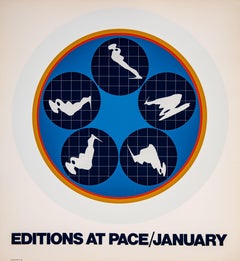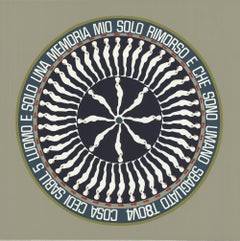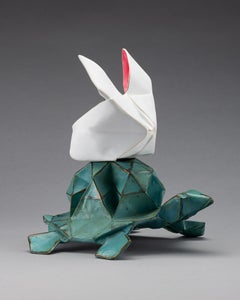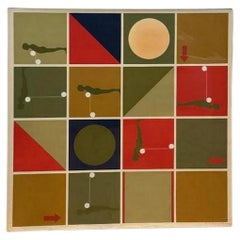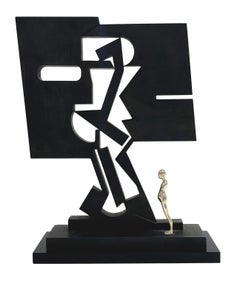Ernest Trova Art
American, 1927-2009
In the early 1960s, St. Louis Sculptor Ernest Trova—who was entirely self-taught—began developing his pivotal theme of Falling Man, a stark and startling image that combines references to classical sculpture with an industrial aesthetic. In his Profile Canto series, Falling Man—depicted as an androgynous, mechanical figure—is folded and segmented as to be nearly undetectable amid the various geometric forms that comprise these works.to
3
1
3
Overall Width
to
Overall Height
to
6
1
1
1
1
2
2
1
1
1
1
1
1
1
1
1
1
1
1
4
4
2
1
1
11
8,816
2,808
1,655
1,313
6
1
Artist: Ernest Trova
Flowing Man
By Ernest Trova
Located in Boca Raton, FL
Edition 37/99
Category
21st Century and Contemporary Contemporary Ernest Trova Art
Materials
Stainless Steel
Ernest Trova, 1969 - "Editions At Pace" Exhibition Poster
By Ernest Trova
Located in Winterswijk, NL
1969 exhibition poster by Ernest Trova, Editions at Pace, created as a color lithograph. This vibrant piece highlights Trova’s distinctive style, making it a valuable addition for co...
Category
20th Century Abstract Ernest Trova Art
Materials
Paper
Double Walking Figure
By Ernest Trova
Located in Boca Raton, FL
rnest Trova was an artist whose signature creation, a gleaming humanoid known as “Falling Man,” appeared in a series of sculptures and paintings and became a symbol of an imperfect humanity hurtling into the future. Mr. Trova was largely known as a sculptor, but his “Falling Man,” a standard of Pop Art, began life as a painted figure, taking shape on his easel in the early 1960s. Faceless, armless, with a hint of a belly and, its name notwithstanding, of indeterminate sex, the figure struck a variety of poses, sometimes juxtaposed with other like figures, sometimes with mechanical appendages.
In October 1963 his one-man show, “Falling Man Paintings,” was the inaugural exhibition of the Pace Gallery on West 57th Street in Manhattan; it sold out, with the works purchased by the Museum of Modern Art, the Whitney Museum, the architect Philip Johnson and others. In three dimensions, the “Falling Man” figure was made from different materials over the years — nickel and chrome-plated bronze, enamel on aluminum, stainless steel — and often, like the Oscar statuette, was polished to an industrial sheen. It was clearly a space age creation, a forerunner of C3PO, the golden robot in “Star Wars.”
“He found the space age both inspiring and dehumanizing,” Arne Glimcher, who founded the Pace Gallery, now PaceWildenstein, said in an interview on Friday. By the end of the 1960s, “Falling Man” had become Mr. Trova’s trademark, provoking Hilton Kramer, the art critic of The New York Times, to write that Mr. Trova had subjected his favorite figure “to almost as many variations as the Kama Sutra describes for the act of love.”
Ernest Tino Trova Jr. was born in St. Louis on Feb. 19, 1927. Shortly after his high school graduation his father, an industrial tool designer and inventor, died, and young Ernie, as he was known, went to work, most significantly as a window dresser for a department store. His early paintings were in the Abstract Expressionist mode, but his attentiveness to the mannequins had an influence on his art. Through the 1970s and 1980s he continued with “Falling Man,” though he also became interested in formalized, almost mechanical-seeming landscapes, and the figures began to appear, reduced in size, within the context of abstractly rendered gardens.
A self-taught artist with an impish wit and an eccentric turn of mind, Mr. Trova craved the recognition that was available to artists only in New York City, but he never visited for more than a week at a time and made almost no friends among New York artists. He did befriend Ezra Pound. As a fevered fan of Julio Iglesias, he went to the singer’s concerts all over the United States. “Ernie had a fabulous fantasy life,” Richard Solomon, the president of Pace Prints, the publishing arm of PaceWildenstein, said in an interview. “He had a persona he used to hide behind that he called ‘Junior Person.’ He was a wonderful man, but an oddball to beat the band.”
Mr. Trova left the Pace Gallery in the mid-1980s and signed with an inexperienced dealer in St. Louis. His profile went into decline, except in his hometown, where his donation of many of his works helped create the Laumeier Sculpture Park. He continued to work until shortly before his death. Most recently he was making collages using magazine...
Category
20th Century Ernest Trova Art
Materials
Stainless Steel
1969 Ernest Trova 'Man is Only a Memory' Pop Art Silk-screen
By Ernest Trova
Located in Brooklyn, NY
“Man is Only a Memory” is a captivating silkscreen by Ernest Trova, published in 1969 by Multiples, Inc. This artwork, part of a small edition of fewer than 300 pieces, was created f...
Category
1960s Pop Art Ernest Trova Art
Materials
Screen
Hardback monograph of renowned sculptor: TROVA (hand signed by Ernest Trova)
By Ernest Trova
Located in New York, NY
Ernest Tino Trova
TROVA (hand signed by Ernest Trova), 1978
Hardback monograph with dust jacket (hand signed by Ernest Trova)
Hand signed by Ernest Trova on the half title page
11 × ...
Category
1970s Abstract Ernest Trova Art
Materials
Paper, Ink, Mixed Media, Lithograph, Offset
Double Flapman
By Ernest Trova
Located in Boca Raton, FL
AP 2
Ernest Trova was an artist whose signature creation, a gleaming humanoid known as “Falling Man,” appeared in a series of sculptures and paintings and became a symbol of an imperfect humanity hurtling into the future. Mr. Trova was largely known as a sculptor, but his “Falling Man,” a standard of Pop Art, began life as a painted figure, taking shape on his easel in the early 1960s. Faceless, armless, with a hint of a belly and, its name notwithstanding, of indeterminate sex, the figure struck a variety of poses, sometimes juxtaposed with other like figures, sometimes with mechanical appendages.
In October 1963 his one-man show, “Falling Man Paintings,” was the inaugural exhibition of the Pace Gallery on West 57th Street in Manhattan; it sold out, with the works purchased by the Museum of Modern Art, the Whitney Museum, the architect Philip Johnson and others. In three dimensions, the “Falling Man” figure was made from different materials over the years — nickel and chrome-plated bronze, enamel on aluminum, stainless steel — and often, like the Oscar statuette, was polished to an industrial sheen. It was clearly a space age creation, a forerunner of C3PO, the golden robot in “Star Wars.”
“He found the space age both inspiring and dehumanizing,” Arne Glimcher, who founded the Pace Gallery, now PaceWildenstein, said in an interview on Friday. By the end of the 1960s, “Falling Man” had become Mr. Trova’s trademark, provoking Hilton Kramer, the art critic of The New York Times, to write that Mr. Trova had subjected his favorite figure “to almost as many variations as the Kama Sutra describes for the act of love.”
Ernest Tino Trova Jr. was born in St. Louis on Feb. 19, 1927. Shortly after his high school graduation his father, an industrial tool designer and inventor, died, and young Ernie, as he was known, went to work, most significantly as a window dresser for a department store. His early paintings were in the Abstract Expressionist mode, but his attentiveness to the mannequins had an influence on his art. Through the 1970s and 1980s he continued with “Falling Man,” though he also became interested in formalized, almost mechanical-seeming landscapes, and the figures began to appear, reduced in size, within the context of abstractly rendered gardens.
A self-taught artist with an impish wit and an eccentric turn of mind, Mr. Trova craved the recognition that was available to artists only in New York City, but he never visited for more than a week at a time and made almost no friends among New York artists. He did befriend Ezra Pound. As a fevered fan of Julio Iglesias...
Category
20th Century Contemporary Ernest Trova Art
Materials
Stainless Steel
The Encounter
By Ernest Trova
Located in Missouri, MO
Ernest Trova
"The Encounter" 1994
Chrome Plated Steel
Approx 24 x 26 x 24 inches
Edition 1/8
Known for his Falling Man series in abstract figural sculpture, he created hard-edge ima...
Category
1990s American Modern Ernest Trova Art
Materials
Stainless Steel
Price Upon Request
Related Items
Road Trip- desktop 11/50- Kevin Box and Beth Johnson
By Kevin Box
Located in Napa, CA
It took two years of tireless experimentation for me to develop the process of casting paper into bronze, another seven years to perfect, and it continues to evolve today.” - Kevin B...
Category
2010s Contemporary Ernest Trova Art
Materials
Bronze, Stainless Steel
Painting with Two Balls I /// Pop Art Jasper Johns Minimalism Colorful Modern
By Jasper Johns
Located in Saint Augustine, FL
Artist: (after) Jasper Johns (American, 1930-)
Title: "Painting with Two Balls I"
Series: Facsimile Catalogue of Jasper Johns Prints
*Issued unsign...
Category
1970s Abstract Ernest Trova Art
Materials
Laid Paper, Lithograph, Offset
$800
H 22.88 in W 17.5 in
"Altered States of an Autorittrati" 3rd State, Modernist Blue Self-Portrait
By I. Colon
Located in Soquel, CA
Bold modernist self portrait in blue, a lithograph by California artist I. Colon (20th Century). Numbered, titled, and signed along the bottom edge ("2/6 "Altered States of an Aut...
Category
Late 20th Century Abstract Impressionist Ernest Trova Art
Materials
Paper, Ink, Lithograph
$399 Sale Price
20% Off
H 18 in W 14 in D 0.25 in
"Orange Row", Abstract Geometric Minimalist Composition w Ovals, Limited Edition
By Geoffrey Bowman
Located in Soquel, CA
"Orange Row", Abstract Geometric Minimalist Composition w Ovals, Limited Edition
Delicate and perfect ovals in orange, yellow, red, and blue are purposefully arranged on lined paper...
Category
1990s Abstract Geometric Ernest Trova Art
Materials
Paper, Ink, Lithograph, Etching
$556 Sale Price
20% Off
H 32 in W 20 in D 0.25 in
I'll Take Manhattan (large signed 3D mixed media serigraph)
By Charles Fazzino
Located in Aventura, FL
3D constructed mixed media serigraph on paper. Hand signed lower right by Charles Fazzino. Hand numbered 357/400 lower left. Artwork size 37 x 29.5 inches. Frame size 49 x 40 in...
Category
21st Century and Contemporary Pop Art Ernest Trova Art
Materials
Mixed Media, Screen
$2,962 Sale Price
25% Off
H 49 in W 40 in D 2 in
Composition - Original Lithograph by Jean-Paul Riopelle - 1968
By Jean-Paul Riopelle
Located in Roma, IT
Composition is an original lithograph realized by Jean-Paul Riopelle for the Art Magazine Derrière le Miroir, no. 171.
The artwork is from the art magazine Derriere Le Miroir. Print...
Category
1960s Abstract Ernest Trova Art
Materials
Paper, Lithograph
$474
H 14.85 in W 10.83 in D 0.04 in
Exhibition Poster for Kandinsky at Galerie Karl Flinker 1977 in Ink on Paper
By Wassily Kandinsky
Located in Soquel, CA
Exhibition Poster for Kandinsky at Galerie Karl Flinker 1977 in Ink on Paper
Poster with a reproduction of "Merry Structure" by Vassily Kandinsky (Russian, 1866-1944). This posted is for a show at Galerie Karl Flinker a Paris, in 1977. The poster was printed by IMP. IDL Graphique, Paris. Kandinsky's "Merry Structure" contains a variety of abstract geometric shapes, laid out in a harmonious composition. There are hints of architectural, figurative, and landscape-like objects, in a manner that is open to interpretation.
Presented in a new white mat with foamcore backing.
Mat size: 40"H x 28"W
Poster size: 33"H x 21"W
At the relatively advanced age of nearly thirty, Vasily Vasilievich Kandinsky abandoned a burgeoning career as a teacher of law in Moscow to take up studies as a painter. In 1896 he moved to Munich to study, enrolling in the private art academy established by the Slovenian painter Anton Ažbe, where he joined a number of other Russian artists, including Marianne von Werefkin...
Category
1970s Abstract Geometric Ernest Trova Art
Materials
Paper, Ink, Lithograph
$750
H 40 in W 28 in D 0.25 in
Gold Leaf and Mesh Lithograph
By Patricia A. Pearce
Located in Soquel, CA
Stunning horizontal abstracted mesh and gold-leaf lithograph on heavy bond paper with artist's protocol notes (for future projects) by Patricia A. Pearce (American, b. 1948). Unsigne...
Category
Late 20th Century Abstract Ernest Trova Art
Materials
Gold Leaf
$540 Sale Price
20% Off
H 13.5 in W 48 in D 0.5 in
NICK SMITH - BEAUTY. Limited edition hand signed Pop Art Design Modern
By Nick Smith
Located in Madrid, Madrid
NICK SMITH - BEAUTY
Date of creation: 2022
Medium: Giclée and screen printed varnish on paper
Edition: 66
Size: 62 x 60 cm
Condition: Brand new, in mint conditions and never framed
...
Category
2010s Pop Art Ernest Trova Art
Materials
Varnish, Archival Paper, Giclée, Screen
$4,446
H 24.41 in W 23.63 in
Rio de Janeiro
By Robert Rauschenberg
Located in Brooklyn, NY
Rio de Janeiro is a colorful, bold, graphic, and visually compelling offset-lithograph by blue chip, pop artist Robert Rauschenberg. In 1991, he was involved with th...
Category
1990s Pop Art Ernest Trova Art
Materials
Archival Ink, Archival Paper, Lithograph, Offset
Tomato-Beef Noodle O's
By Andy Warhol
Located in New York, NY
Among the artist’s most iconic and recognizable images, Andy Warhol created Tomato-Beef Noodle O's in 1969. As one of ten independent images within the famed Soup II series, this is...
Category
1960s Pop Art Ernest Trova Art
Materials
Screen
Basquiat Annina Nosei Gallery 1982 (Basquiat anatomy announcement)
By Jean-Michel Basquiat
Located in NEW YORK, NY
Jean-Michel Basquiat, Annina Nosei Gallery, New York, 1982:
Rare Basquiat announcement card published by Annina Nosei Gallery to advertise the release of ‘Basquiat Anatomy’ (a suite ...
Category
1980s Abstract Ernest Trova Art
Materials
Paper, Lithograph, Offset
Previously Available Items
Pop Art Lithograph “Falling man”, study 1 by Ernest Trova
By Ernest Trova
Located in Pasadena, CA
Ernest Trova was a self-trained American artist blending elements of Pop Art and Surrealism. He profoundly influenced the art world with his expressive and innovative creations. Amon...
Category
Mid-20th Century Pop Art Ernest Trova Art
Materials
Lithograph
H 24.25 in W 24.25 in D 1.75 in
FALLING MAN GOX (SCULPTURE)
By Ernest Trova
Located in Aventura, FL
Bronze and steel sculpture with black patination, on black acrylic base. Etched artist signature with title, date and edition to base underside. Published by Pace Editions. From t...
Category
1970s Pop Art Ernest Trova Art
Materials
Bronze, Steel
1972 Ernest Trova 'Falling Man' Pop Art Blue, Red USA Serigraph
By Ernest Trova
Located in Brooklyn, NY
Paper Size: 25.75 x 25.75 inches ( 65.405 x 65.405 cm )
Image Size: 24.5 x 24.5 inches ( 62.23 x 62.23 cm )
Framed: No
Condition: A: Mint
Additional Details: Limited edition s...
Category
1970s Ernest Trova Art
Materials
Screen
H 25.75 in W 25.75 in D 0.1 in
1969 Ernest Trova 'Man is Only a Memory' Pop Art Silk-screen
By Ernest Trova
Located in Brooklyn, NY
“Man is Only a Memory” is a captivating silkscreen by Ernest Trova, published in 1969 by Multiples, Inc. This artwork, part of a small edition of fewer than 300 pieces, was created f...
Category
1960s Pop Art Ernest Trova Art
Materials
Screen
H 15 in W 15 in D 0.1 in
1972 Ernest Trova 'Falling Man' Pop Art Blue, Red USA Serigraph
By Ernest Trova
Located in Brooklyn, NY
Paper Size: 25.75 x 25.75 inches ( 65.405 x 65.405 cm )
Image Size: 24.5 x 24.5 inches ( 62.23 x 62.23 cm )
Framed: No
Condition: A: Mint
Additional Details: Limited edition s...
Category
1970s Ernest Trova Art
Materials
Screen
H 25.75 in W 25.75 in D 0.1 in
Walking Man with Disc
By Ernest Trova
Located in Wilton Manors, FL
Beautiful figural sculpture by American artist, Ernest Tino Trova (1927-2009). Walking Man with Disc (working study), 1966. Brass sheet with cut-out figure in profile, sheet measures...
Category
Mid-20th Century Abstract Ernest Trova Art
Materials
Brass
Shadows, Planes and Targets
By Ernest Trova
Located in Fairlawn, OH
Shadows, Planes and Targets
Screen print, 1972
Unsigned (as usual for this format)
Screen print announcement for Pace Columbus exhibition of Trova's artwork, 1972, announcing the por...
Category
1970s American Modern Ernest Trova Art
Materials
Screen
Pace Editions Prospectus for F. M. Manscapes Portfolio
By Ernest Trova
Located in Fairlawn, OH
Unsigned
Note: This is the lithograph announcement for the publication of the F. M. Manscapes Portfolio of 10 original screen prints, published in an edition of 175 portfolios. The...
Category
1970s Abstract Ernest Trova Art
Materials
Lithograph
TRISTAN GOX (SCULPTURE)
By Ernest Trova
Located in Aventura, FL
Steel and bronze sculpture. Inscribed signature and numbered. Artwork is in excellent condition. Certificate of authenticity included. Edition of 125. All reasonable offers will be...
Category
1970s Pop Art Ernest Trova Art
Materials
Bronze, Steel
Ernest Trova art for sale on 1stDibs.
Find a wide variety of authentic Ernest Trova art available for sale on 1stDibs. You can also browse by medium to find art by Ernest Trova in metal, stainless steel, paper and more. Much of the original work by this artist or collective was created during the 20th century and is mostly associated with the contemporary style. Not every interior allows for large Ernest Trova art, so small editions measuring 9 inches across are available. Customers who are interested in this artist might also find the work of Richard Tuttle, Peter Reginato, and Robert Holmes. Ernest Trova art prices can differ depending upon medium, time period and other attributes. On 1stDibs, the price for these items starts at $250 and tops out at $55,000, while the average work can sell for $6,600.

